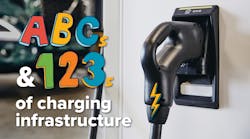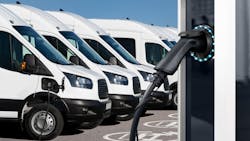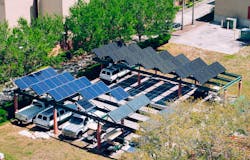If anything was apparent at NTEA's Work Truck Week in early March, at other trucking industry shows this spring, and surely will be evident next week during ACT Expo in Anaheim, California, it's this: more and more fleets, running every class of commercial vehicle, hear the chatter and notice the momentum, and end up asking about electrifying their routes and whether EVs are right for their freight-hauling operations. Sustainability, arguably, is this generation's top conversation in trucking.
Their next urgent concern usually involves power: tapping the grid, where and how to plug in, for how long, and whether their local utility can provide the juice; often, that answer is "definitely maybe" but lacks in any certainty. More questions lead to charging infrastructure: where do their companies buy, build, or lease it, whether they can afford the plug-ins, and the big if: what it all means (the vehicles and their range, yes, but also the charging) for TCO and ROI.
There are lots of knowns, but many unknowns … like the grid, for example.
See also: At alt-truck summit, ‘infrastructure’ the keyword
A large-scale 2021 study, conducted by Hitachi Energy and National Grid, explored the impact of charging large numbers of commercial vehicles on local grids and found that some grids could be overloaded by these vehicles' charging needs if system upgrades or alternative solutions don't progress in tandem with EV adoption. U.S. electrical infrastructure needs to evolve to handle the extra load on the grid that will result from the widespread adoption of EVs, the study found, because the transmission system was designed almost 50 years ago for another purpose entirely: delivering juice from centralized power-generation sources.
There’s a lot for the C-suite to digest, to plan for the knowns but also anticipate the unknowns and contemplate building their future fleets. If they came to Work Truck Week in Indianapolis, they learned this is all best planned and realized step-by-step, from one industry stakeholder, Amy Dobrikova, who gave clear voice to a process that can be confusing and intimidating.
Dobrikova, who is VP of fleet solutions for Blink Charging, led a session during the Green Truck Summit at NTEA called Electric Foundations: Charging Your Infrastructure that guided attendees in the steps (building blocks, actually, because Legos were literally involved) to electrification with a focus on charging and infrastructure, because that's what Blink does. Since her talk, FleetOwner has talked to more stakeholders in EV charging and infrastructure.
See also: EV charging solutions to help bridge the ‘gap to grid’
Dobrikova made it kind of a game, challenging participants to "put the blocks in the order you think they should be and start with the foundation at the bottom"—even though the stakes for U.S. freight-hauling fleets are very high for their ROI. There's much pressure to electrify. “It’s so exciting to see the growth of the industry," she remarked. "There is a totally different plan for heavy duty, which is going to need a lot of power, a lot of fast charging.”
Besides Blink, there are many other players in vehicle charging and related equipment and infrastructure, some in passenger vehicles but more crossing over to the commercial side. They include: ABB, ABM Industries, Burns-McDonnell, Black & Veatch, ChargePoint, Conductix-Wampler, Duke Energy, Eaton, EVBox, Gilbarco Veeder-Root, Hitachi Energy, InCharge, Schneider Electric, Shell Recharge Solutions, Siemens, Wallbox, WAVE Technologies by Ideanomics, and Webasto.
Right now, these companies and people like Dobrikova, Rick Eckert and Paul Gioupis at Zeem Solutions in California (the state that unquestionably leads in transportation electrification), Volvo Trucks in Virginia, and Pitt Ohio, with its microgrid in the Cleveland suburbs, among many others, are trying to prove the doubters wrong and help plug-in fleets and the gear they'll use penetrate the marketplace. Because they're trying to make a profit, yes, but also because they say they believe in sustainability. And the U.S. and state governments, California's CARB most prominently, are telling them it will be required in the not-too-distant future.
See also: Biden administration OKs California waivers to mandate electric trucks
The supply chain will untangle, OEMs are multiplying, the EVs will be ready. The key to an electric future, increasingly, is charging, fixed or mobile. The steps aren’t complicated to identify; they're just harder and more expensive to execute. While the upfront costs are high, stakeholders like the North American Council for Freight Efficiency are demonstrating that an electrified fleet could be cheaper to operate than a fossil fuel-burning one, giving fleets incentive to follow the steps.
Building blocks
In her session at NTEA, the Blink fleet solutions VP lit the path, so to speak, to charging infrastructure.
Dobrikova might know a thing or two about that. Her company is a global supplier of EV charging solutions, owns and operates plug-in locations themselves, and will be one of three providers that will provide the U.S. Postal Service with up to 41,500 charging units as part of the Postal Service's electrification strategy. Blink also is an approved supplier of charging and infrastructure for dealerships that are designated as EV-certified, she said.
See also: New trucking coalition looks to set realistic decarbonization path
In a separate email exchange with FleetOwner, Brian Cook, senior product manager at energy equipment and component supplier and cable-management vendor Conductix-Wampfler, also had opinions about what fleets must consider when getting ready to build EV infrastructure. Start, he said, by asking yourself three questions:
- “What vehicles am I working with? Determine how many vehicles are in the fleet, as well as the make and model. Each vehicle will have a specific charging port location, which is important to be aware of when considering infrastructure and cable needs,” he said.
- “What is the typical vehicle usage? Consider the hours and type of operation. Is it an application where you have a few vehicles in and out of the facility during the day? Is there time to stop and charge during the day? Or conversely, will those vehicles be outside the facility for 10 hours per day? Once you understand the typical stops, usage, and fleet-owner profile, you can assess the charging profile.
- “What will the usage look like in the future? EV charging infrastructure is a significant investment, so you want to avoid making major (costly) adjustments down the line just because you didn’t plan for it properly. Take the time to understand where your fleet is now and where you will be in the future."
In Indianapolis, Dobrikova passed out colorful cards and asked attendees to game out the proper order of the 11 steps that she recommends fleets take to go from zero to all the charging plugs they might need or want. She even gave select attendees extra-large Lego blocks to lock the colors what she recommends is the correct order. "This is my opinion of the order, and yes there is variability of that order, and every application is different," she said.
Review funding, rebates, grants, and incentives
"There is so much funding out there right now, whether it's federal funding [or] state grants," she said, adding that Blink uses a funding analyzer that starts with a fleet's location (its state, its ZIP code) and determines where the funding and incentives are available, either federal or state. Other charging gear/infrastructure manufacturers are plugged into where financing is and should be able to show fleets the way to the money.
Select electric vehicle specifications
This will determine what type of power hookups you need. EVs brought to the industry by several OEMs are in development and testing and have penetrated the marketplace to varying degrees, as has been evident for the better part of two years and should be the case at ACT Expo. All these EVs have connections for standard AC (J1772) or CCS1 (that accommodate faster charging) ports. When spec’ing a commercial EV, this is perhaps most important—besides evaluating whether your fleet has a “use case” that currently fits with electrification and your total cost of ownership.
Select your charging hardware
Dobrikova said one consideration—if your mid-class or lighter commercial vehicles and work trucks go home with employees—is residential charging that might run through NEMA 6-50 wall receptacles (like, for example, an electric dryer, or many other appliances). So make sure they're homes have those wall plugs, as most do.
She also emphasized during her presentation that the life expectancy of most charging hardware is about a decade—many if they're located in depots like those Blink installs or helps set up are cellular-connected for status reporting and go back to the outdated 3G standard but that the more durable ones can last 20 to 30 years—so think about how long and who might use charging as well as for which EVs.
See also: With EV adoption, trucks are the easy part
"These chargers have to last, they have to be durable. That's important to your fleet," she said.
They also have to be flexible—like in featuring more advanced technology that can monitor their performance and make sure they are functioning. The Webasto TurboConnect is one such product, among many others on or coming to the marketplace. The TurboConnect Level 2 unit charges up to 11.5kW charging power at 240V and a maximum output of 48A. A companion fleet product, the Webasto ChargeConnect dashboard, allows easy access to manage complex multi-charging sessions, check on device status, retrieve charging history, control energy consumption, and more.
Schedule a site visit
“Blink sends an electrician out, who comes out to look at your [electrical] panel or panels, to look at your capacity, and your access to your utility’s electric grid," Dobrikova said.
Conductix-Wampfler’s Cook added: “Find an electric vehicle supply equipment (EVSE) OEM to help convert your fleet vehicle usage requirements into power requirements. An EVSE OEM will also have the knowledge to recommend the hardware that controls the power supply to each individual vehicle.”
Cook also pointed out that some fleet owners will be working in environments where there isn’t any utility regulation. “That means the conversations with EVSE OEMs are more important because they’ll install the hardware that helps control how much power goes to each vehicle. Just make sure you also have conversations with the utilities to understand any capacity limitations and surcharges.”
He also added: “The steps for fleet owners to take before investing in EV charging infrastructure are the same regardless of the vehicle class. However, when you get into heavy-duty fleet charging, you need significantly larger charging cables. And as you get larger cables, you need to be thoughtful about where those cables are mounted so people can easily access and operate them. Typically, cables this large are mounted on the ceiling with motor-driven reels.”
The first part of this series appeared this week—and FleetOwner will be back next week during ACT Expo with Part 3 and more ABCs and 123s of electric vehicle charging and infrastructure.






